Firstly let me start by stating that I am by no means an expert in float fishing. I am however more than happy to share with you the things that I do know, including just how enjoyable float fishing can really be.
Float fishing is a form of bait fishing, where you use some kind of float, or floating device, to suspend your bait off the bottom or close to the surface of the water column.
There are a whole host of different types of floats ranging from the most common, (and one I usually use) the simple red and white bubble float, to the complex rigs of quill floats, pencil floats and such. There are berley floats, which you can fill with berley that breaks down and seeps into the water leaving a scent, attracting the fish closer to your bait; there are rattling floats that can be made to rattle with a couple of sharp tugs on the line, simply to attract the fish's attention; there are reflective floats that reflect the sun directly into the water and send a flash each time the float faces the right angle; popping floats; click on floats; slider floats; torpedo floats; the list just keeps going on and on... Some of the older gentleman even use a cork from a wine bottle!
Each of these floats has its own purpose, some are better suited to saltwater and some are better suited to freshwater, and then there are floats that are better suited to more specific fish species. Some fish are spooked off by a float’s buoyancy. The moment the fish bites the bait and feels the resistance of the float it takes off. Then there are some stupid fish, such as carp, that will just keep pulling against the float until the buoyancy of the float sets the hook into the fish’s mouth.
So the first thing you need to do when you decide to get into float fishing is learn a little bit about the fish species you are targeting, what they feed on, and most importantly why it is that you think you need a float.
One of my favourite float fishing places is Khancoban pondage in NSW. This small relatively shallow lake has a lot of aquatic weeds, which are home to squillions of mudeyes that hatch out into dragonflies when conditions are favourable. Because of all of the weed, it is almost impossible to fish your mudeye unweighted otherwise it will just climb straight into the weeds and hide. It is also impossible to fish your mudeye with a sinker as it will most likely get snagged on the aquatic weed, so the best thing to do is use a float!
By knowing how deep the water is, and how far under the surface the weed is you can rig your float to allow the mudeye to sink to just above the weed bed. For example, if the water is 10ft deep, and the aquatic weed extends 5ft from the bottom, then you can fish your float with a dropper of around 4-5ft. That will keep your mudeye hanging out on display just above the top of the weed for the fish to see.
While I am on the subject of trout, now is a good time to mention the effect that the buoyancy of the float has on fish species. Trout are a perfect example as they are quite cunning and easily spooked off by anything unnatural. With trout, if your float is too big, or has too much buoyancy, the trout will feel too much resistance when it takes the bait and quite often keep moving along. When I fish at Khancoban pondage with my mate Sandy Hector, he often uses a complex float system with next to no buoyancy whatsoever. As I usually use a plain red and white bubble float with a lot of buoyancy, he usually out fishes me.
Sandy likes to use a long thin float, such as a pencil float or quill float. This float is around 15-20cm long and often has a bulge in the middle and a long dropper extending underneath it. The dropper is weighted and helps to pull the float down, reducing its overall buoyancy. This allows Sandy to still be able to achieve maximum casting distance, have a float that is big enough to see, but with very little buoyancy.
Sometimes Sandy will crimp a split shot sinker onto his dropper just up from his bait to help make the bait sit directly underneath his float. If his bait and split shot are too heavy and slowly pull the float under, he will add a small bit of cork between the split shot and the float to just help lift the split shot and take some pressure off the float. The float has the absolute minimum amount of buoyancy so that when a trout takes the bait, it will swim off with it without realising it is a trap, whereas with my plain old red and white bubble float, the trout will not be able to swim off with the bait so easily.
When you watch someone like Sandy, or any die-hard angler you really begin to get an appreciation for float fishing and how much of an art form it really can be.
As mentioned earlier, there are stacks of different types of floats you can choose from depending on your circumstances. But what's the best rod? Basically any long rod will do. Unless you are a hardcore fisho that spends days sitting on the banks of waterways bait fishing, there is little point in spending huge dollars on a float fishing rod.
You can use your regular trout spinning rods. I use my 6’ and 6’4” spinning rods. Ideally, you want a rod that is at least 7” long, if not longer. Even a super long 8” rod is great. The reason being, that when you reel your line in you can only reel it in as far as the float because the float will not pass thorough the top eye of your fishing rod. So if you are using a short 5’ rod, you really cannot afford for your dropper to be more than 4-5’ long otherwise you will never be able to land your fish.
And it is not just landing the fish that is the problem, it is also casting. You do not really want your hook sitting on, or close to the ground when you cast or you could end up breaking a rod tip. So look for a long rod, preferably somewhere between 7-8’ in length.
With the reel, once again there is no real need to spend too much money as you will not be making hundreds of casts throughout any day on the water. A simple eggbeater type reel that balances well with your rod with monofilament line of around 4-6lb is usually sufficient.
Trout are a sought-after species by float fishers as they often feed close to the surface, particularly at sunrise and sunset.
As mentioned, mudeyes fished above weed beds are dynamite, so are crickets fished underneath a float and worms when conditions are favourable (usually during periods of flooding or high water levels).
Carp are probably the easiest, and most fun fish to catch by float fishing. A small bubble float with a few corn kernels, or a bit of bread and you can't go wrong.
Catching carp is a great way to practise your float fishing skills.
Catching redfin under a float can be great fun providing you are at the right place at the right time.
Small live freshwater shrimp suspended over, or beside a snag pile, or in front of some cumbungi in a known redfin waterway is a great place to start. Usually a smaller float is beneficial as redfin are not a large fish and may be affected by the float’s buoyancy.
I have never caught yellowbelly while float fishing, I must add that to my ‘to-do’ list. If I were to head out and try, I would probably use either a small yabby, or a bunch of fat garden worms and fish them with the dropper as close as possible to the snags and likely yellowbelly holding structure.
Once again, something I have never done. Just writing this article has inspired me to get out and give this one a crack!
In the summer months, I would use a plain bubble float as the strike from a Murray cod would pull the float under so quickly that the buoyancy of the float would not be a problem. A large yabby fished close to a big fallen tree would work.
Post Christmas I would try fishing a cicada only 70-80cm underneath my float close to sunset, and fish it very close to the bank. This is bound to work!
Reads: 12964
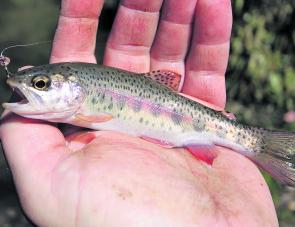
Even small trout can be caught under a float. This tiny rainbow took a liking to my bunch of worms as it drifted through a deep pool in a small mountain stream. I was using a tiny bubble float with a dropper about 80cm long.

This particular design of quill float is used for float fishing in the wind. It lays flat on the water with very little buoyancy. One bite from a hungry fish will pull this float under.
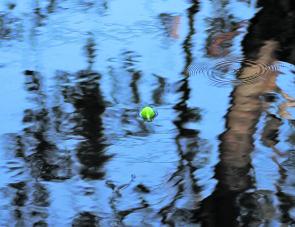
This bubble float is designed so that you can put water into the float. The more water you put in the float, the lower it sits in the water and the less buoyancy the float has. The extra weight also assists with casting distance.
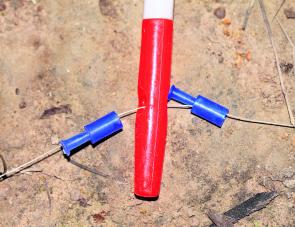
These blue float stoppers are a fantastic idea, they can be put on and taken off easily without having to rig your line, and can allow you to fish your float similar to how you would fish a running sinker.
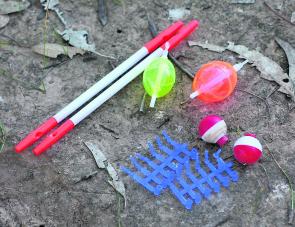
A selection of bubble floats, quill floats and float stoppers. The red and white floats are the most basic, cheapest and easiest to use, but probably the most ineffective.
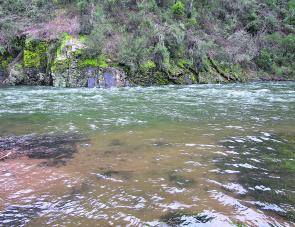
A big backwater in a swollen river. Conditions like this would be ideal for fishing a bunch of worms under a skinny float such as a quill float or pencil float for trout.
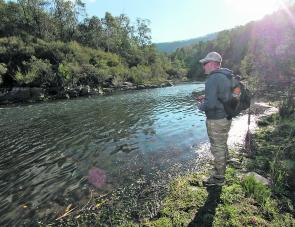
This is the Mitta Mitta River. Large deep rivers like this are ideal for float fishing, especially during the warmer months with live mudeyes. The cunning trout that have seen too many lures will often take a live mudeye if it is presented naturally.
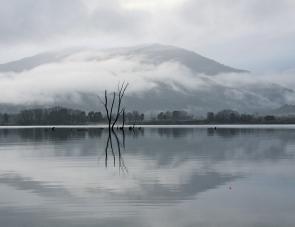
I took this photo a few years ago at Khancoban pondage on a very cold winter’s day. The only colourful object on such a dull day is my bright orange bubble float in the bottom right hand corner. Several trout were caught on this day using live mudeyes for




